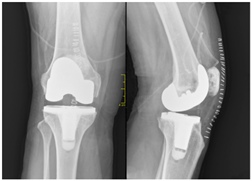 The metal-on-metal devices are used in about one third of all hip replacement surgeries in the US each year, totaling a quarter million annually. The New York Times reported yesterday that some of the nation's leading orthopedic surgeons have stopped or significantly reduced their use of the devices to reports of severe tissue and bone damage in some patients.
The metal-on-metal devices are used in about one third of all hip replacement surgeries in the US each year, totaling a quarter million annually. The New York Times reported yesterday that some of the nation's leading orthopedic surgeons have stopped or significantly reduced their use of the devices to reports of severe tissue and bone damage in some patients.What's more, metal-on-metal devices are beginning to fail far sooner than expected. Despite an expected life span of 15 years or more, some have required replacement surgery within a year or two.
Metal-on-metal are ball-and-socket devices fashioned from metals like cobalt and chromium. It was believed that the devices would be much more durable than previous implants. However, studies have found that when the devices break down prematurely, they sometimes generate metallic debris that absorbs into the body. The resulting inflammation can trigger pain, death of tissue in the hip joint and the loss of surrounding bone. The cause and scope of the issue remain unclear, but doctors have noted that replacement surgeries for metal-on-metal devices can be complex and that the absorption of metal debris into tissue or bloodstream can leave patients with lasting complications.
Surgeons at Rush University Medical Center performed about two dozen replacement procedures because of metal debris over the last year, said Dr. Joshua Jacobs, head of the orthopedic surgery department.
A similar number of patients have had metal-on-metal hips removed at the Mayo Clinic, according to Dr. Daniel Berry, Mayo's head of orthopedic surgery. Dr. Berry added that surgeons at the Mayo Clinic reduced by 80 percent their use of metal-on-metal implants over the last year in favor of those fashioned from combinations of metal and plastic or other materials.
READ MORE DEFECTIVE PRODUCTS LEGAL NEWS
Some surgeons are concerned that we are only now beginning to see the leading edge of a mounting problem, given that the technology is still relatively new.
Three years ago Gregory Smith, 35, of Milan, Illinois received a metal-on-metal joint to correct a congenital hip disorder. The unemployed heavy-equipment operator reported he began experiencing severe pain almost immediately. Dr. Brett Levine, an orthopedic surgeon at Rush University, replaced it last year. The soft tissue surrounding Smith's left hip was severely inflamed, and some of it had died.
"It was like having a fire taken out of your body," said Smith of the removed joint.
Dr. Levine told the New York Times he is replacing metal-on-metal devices at the rate of one a month.
